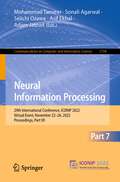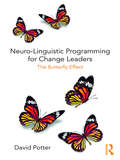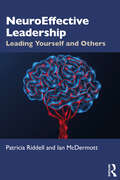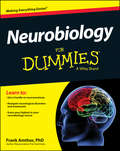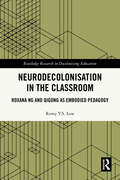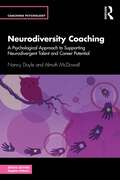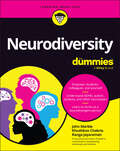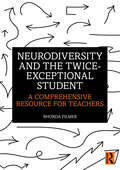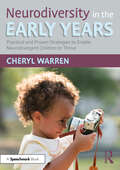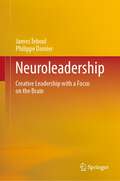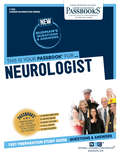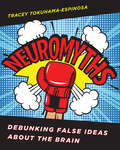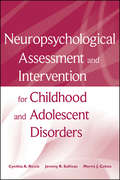- Table View
- List View
Neural Information Processing: 29th International Conference, ICONIP 2022, Virtual Event, November 22–26, 2022, Proceedings, Part VII (Communications in Computer and Information Science #1794)
by Seiichi Ozawa Adam Jatowt Sonali Agarwal Mohammad Tanveer Asif EkbalThe four-volume set CCIS 1791, 1792, 1793 and 1794 constitutes the refereed proceedings of the 29th International Conference on Neural Information Processing, ICONIP 2022, held as a virtual event, November 22–26, 2022. The 213 papers presented in the proceedings set were carefully reviewed and selected from 810 submissions. They were organized in topical sections as follows: Theory and Algorithms; Cognitive Neurosciences; Human Centered Computing; and Applications.The ICONIP conference aims to provide a leading international forum for researchers, scientists, and industry professionals who are working in neuroscience, neural networks, deep learning, and related fields to share their new ideas, progress, and achievements.
Neuro-Ed Assessments and Screeners: Quick and Highly Effective Assessments of Common Disorders for Children and Adolescents
by Peter Thompson Dodi PoulosNeuro-Ed Assessment and Screeners are fast and effective assessment forms for busy mental health and educational professionals. These practical assessments were created by practitioners who know the needs of professionals working in the field. Th
Neuro-Linguistic Programming for Change Leaders: The Butterfly Effect
by David PotterWe know a lot about change leadership. We understand how to design change programmes, and we know how to prescribe best practice change methods. Yet, despite all this knowledge, it is reported that up to 70% of change leadership projects fail to realize many of their objectives. The fault lines are cited as occurring at the micro level of social interaction. What we don’t adequately explain and demonstrate within the change leadership literature is how change leaders may consciously generate in themselves and in others resourceful mindsets, emotions, attitudes, and behaviours to enable positive change leadership dynamics. Neuro-Linguistic Programming for Change Leaders: The Butterfly Effect fills this gap by connecting the practices of personal development with those of corporate change leadership. This book has the vision of advancing NLP as a serious technology in the change leader’s tool box. The book introduces to operations managers, HR practitioners, OD specialists, and students of management new ideas and practices, which can transform their effectiveness as change leaders. It focuses on the benefits of applied NLP to change leaders as a generative change toolkit. Secondly, the book provides a model that shows change leaders how to build a climate of psychological safety to establish rapport with stakeholders. Thirdly, the book provides a strategy for enabling broader cultural change and stakeholder engagement throughout the organization.
NeuroEffective Leadership: Leading Yourself and Others
by Ian McDermott Patricia RiddellViewing leadership through a neuroscientific lens is transforming the way we understand, interpret, manage, and lead ourselves and others. This book provides practical neuroscientific approaches to leadership that promote far greater effectiveness at both a personal and team level.The authors, who are experts in the fields of neuroscience and leadership, distil and combine deep neuroscience knowledge with leadership coaching tools to present clear guidance, based on years of practice, to help develop more effective leadership in organisations. Using a clear structure throughout, each key element in how to improve self-awareness and how to work effectively as a team leader is presented. Topics covered include how to develop an achieving mindset and increase resilience by reducing stress and overwhelm, how to turn rumination into action, and, at a team level, how to promote psychological safety, perceive others’ realities, and create metaphors that keep teams on message.With its clarity and practical applications, this book is the perfect guide for leaders and managers wishing to improve their understanding of their own and others’ behaviour. It offers guidance on how to build the skills needed to create more effective teams in the workplace. It is also a very useful tool for leadership coaches.
Neurobiology For Dummies
by Frank AmthorThe approachable, comprehensive guide to neurobiology Neurobiology rolls the anatomy, physiology, and pathology of the nervous system into one complex area of study. Neurobiology For Dummies breaks down the specifics of the topic in a fun, easy-to-understand manner. The book is perfect for students in a variety of scientific fields ranging from neuroscience and biology to pharmacology, health science, and more. With a complete overview of the molecular and cellular mechanisms of the nervous system, this complete resource makes short work of the ins and outs of neurobiology so you can understand the details quickly. Dive into this fascinating guide to an even more fascinating subject, which takes a step-by-step approach that naturally builds an understanding of how the nervous system ties into the very essence of human beings, and what that means for those working and studying in the field of neuroscience. The book includes a complete introduction to the subject of neurobiology. Gives you an overview of the human nervous system, along with a discussion of how it's similar to that of other animals Discusses various neurological disorders, such as strokes, Alzheimer's disease, Parkinson's disease, and schizophrenia Leads you through a point-by-point approach to describe the science of perception, including how we think, learn, and remember Neurobiology For Dummies is your key to mastering this complex topic, and will propel you to a greater understanding that can form the basis of your academic and career success.
Neurocounseling: Brain-Based Clinical Approaches
by Lori A. Russell-Chapin Thomas A. Field Laura K. JonesThis text presents current, accessible information on enhancing the counseling process using a brain-based paradigm. Leading experts provide guidelines and insights for becoming a skillful neuroscience-informed counselor, making direct connections between the material covered and clinical practice. In this much-needed resource—the first to address neurocounseling concepts across the counseling curriculum—chapters cover each of the eight common core areas in the 2016 CACREP Standards in addition to several specialty areas of the Standards. Detailed case studies, questions for reflection, quiz questions, and a glossary facilitate classroom use. *Requests for digital versions from the ACA can be found on wiley.com. *To request print copies, please visit the ACA website here. *Reproduction requests for material from books published by ACA should be directed to permissions@counseling.org
Neurodecolonisation in the Classroom: Roxana Ng and Qigong as Embodied Pedagogy (Routledge Research in Decolonizing Education)
by Remy Y.S. LowThis book extends on the scholarship on decolonising higher education by focusing on classroom pedagogies that can transform students’ embodied affects and habits as conditioned by coloniality.It does so by offering a historical case study of how one exemplary educator – Canadian activist and scholar Roxana Chu-Yee Ng (1951–2013) – drew on traditional Chinese medicine philosophy and Qigong practice to offer an embodied pedagogy that had profound effects on many of her students.This book brings together scholarship from critical education, contemplative pedagogy, the neuroscience of stress, mind–body medicine, and embodied cognition to make the case for the importance of embodied pedagogies in any project for decolonising higher education. An innovative contribution to embodiment and decolonial studies, this book will be of great interest to researchers and postgraduate students exploring interdisciplinary methods.
Neurodevelopmental Disorders: A Definitive Guide for Educators
by Frank E. VargoFrom autism to ADHD to learning disabilities, a guide for all teachers to this constellation of disorders. Developmental deficits in learning and communication in young children are defined as neurodevelopmental disorders. This constellation, newly defined in the DSM-5, represents a range of issues that educators must address. Neurodevelopmental Disorders: A Definitive Guide for Educators provides extensive and practical information to a range of professionals, and to all others who are interested in the complex and often misunderstood disabilities that fall within the general medical and psychological diagnostic categories of neurodevelopmental disability. Noted psychologist and educator Dr. Frank E. Vargo provides a comprehensive overview of neurodevelopmental deficits and disabilities, as well as of their related learning and cognitive processes, with a strong focus on educational considerations, applications, and relevance across academic areas and with a mind to global educational models. Well researched and accessibly written, this book is an up-to-date and authoritative reference to all of the educational and clinical topics in the diagnostic categories of neurodevelopmental disorder. This informative book will provide a primary reference source for all educators, school and clinical psychologists, clinical mental health counselors and therapists, special education and medical professionals, and parents of children with special needs.
Neurodiversity Coaching: A Psychological Approach to Supporting Neurodivergent Talent and Career Potential (Coaching Psychology)
by Almuth McDowall Nancy DoyleNeurodiversity Coaching demystifies the themes and assumptions affecting neurodivergent coachee experiences at work, whilst at the same time exploring the necessary safeguards required for working with this vulnerable group.The book supports existing coaching practitioners, managers and community leaders to understand the essentials of neurodivergence, a term which encompasses ADHD, autism, dyslexia, dyspraxia and Tourette Syndrome, and how these diagnoses require specific coaching approaches to support individuals to thrive at work. This book is practically focused on the “how”, sharing coaching exercises and activities that have been evaluated and researched by authors with extensive experience in the field. Grounded in coaching psychology theory, those with existing knowledge will be able to transfer their skill set to the neurodiversity context and those who are considering learning more about coaching can be signposted to essential knowledge and skills.Neurodiversity Coaching will be suitable for independent coaching practitioners and internal organisational coaches and managers seeking a coaching approach.
Neurodiversity Coaching: A Psychological Approach to Supporting Neurodivergent Talent and Career Potential (Coaching Psychology)
by Almuth Mcdowall Nancy DoyleNeurodiversity Coaching demystifies the themes and assumptions affecting neurodivergent coachee experiences at work, whilst at the same time exploring the necessary safeguards required for working with this vulnerable group. The book supports existing coaching practitioners, managers and community leaders to understand the essentials of neurodivergence, a term which encompasses ADHD, autism, dyslexia, dyspraxia and Tourette Syndrome, and how these diagnoses require specific coaching approaches to support individuals to thrive at work. This book is practically focused on the “how”, sharing coaching exercises and activities that have been evaluated and researched by authors with extensive experience in the field. Grounded in coaching psychology theory, those with existing knowledge will be able to transfer their skill set to the neurodiversity context and those who are considering learning more about coaching can be signposted to essential knowledge and skills. Neurodiversity Coaching will be suitable for independent coaching practitioners and internal organisational coaches and managers seeking a coaching approach.
Neurodiversity For Dummies
by John Marble Khushboo Chabria Ranga JayaramanA quick and easy way to understand neurodiversity as written by neurodivergent people and our families Neurodiversity For Dummies is your essential guide in understanding neurodivergent conditions like autism, ADHD, dyslexia, and more. This quick and easy guide is perfect for anyone needing to know more about neurodiversity. And that’s all of us—because recent estimates say that 15-20% of the world’s population have some form of neurodivergence. Your life is filled with neurodivergent people that you know and love, whether you realize it yet or not. It’s time to learn to support and include the neurodivergent among us, and to understand how neurodiversity impacts society and the workplace. This is for the neurodivergent person wanting to thrive in life, for parents and caregivers seeking success for their child, and for teachers who are working to make a difference in their students’ lives. Filled with practical advice, Neurodiversity for Dummies also provides a helping hand to service providers, assistance for workplace managers and colleagues, and understanding for family members and friends. Imagine a world where we all understood ourselves better and appreciated more deeply the differences in others. No matter how your own brain thinks, Neurodiversity for Dummies is for you. Check out this jargon-free introduction for an essential overview. Explore the Spectrum of Neurodiversity: Understand in plain language the world of autism, ADHD, dyslexia, and other neurodivergent conditions. Unlock Hidden Talents: Move yourself beyond common myths and misconceptions to discover how neurodiversity actually works. Learn how neurodiversity has always been with us, why society needs neurodivergent traits, and how neurodiversity can be a wellspring of innovation, creativity, and out-of-the-box thinking. Discover Yourself: Whether you are a neurodivergent person or not, learn how to understand your own normalcy, advocate for your needs, and build meaningful connections with those who think and experience the world differently than you. Change the World Around You: Be empowered through simple steps you can take to create inclusive environments for neurodivergent individuals in your school or workplace. Uncover proven strategies that cultivate a culture of acceptance and respect, where the unique perspectives of all individuals are valued and celebrated. We believe in providing parents with better supports, empowering individuals with information, and shaping a world where we are all seen and understood. With an author team composed of neurodivergent individuals and parents writing together, Neurodiversity for Dummies is an example of the power of neurodiversity when put into action. It’s why we wrote this for you. Don’t miss your chance to embark on this transformative journey. Order your copy of Neurodiversity for Dummies now to better understand yourself and others, and to join the movement that is revolutionizing how we understand and support the diversity of the human mind.
Neurodiversity and Education
by Amanda Kirby Paul Ellis Abby OsborneHuman brains are diverse: each one of us has a unique set of connections between billions of nerve cells. Neurodiversity is about us all. It is not an exclusive club or one condition, difficulty, difference, or disorder. Understanding more about the concept of neurodiversity helps us consider, respect and appreciate these differences. It helps us see potential rather than deficit. This clear and practical book, which is useful for all apsects of learning and education discusses how an emphasis on neurodiverse ′ability′ can cultivate a better world.
Neurodiversity and Education
by Amanda Kirby Paul Ellis Abby OsborneHuman brains are diverse: each one of us has a unique set of connections between billions of nerve cells. Neurodiversity is about us all. It is not an exclusive club or one condition, difficulty, difference, or disorder. Understanding more about the concept of neurodiversity helps us consider, respect and appreciate these differences. It helps us see potential rather than deficit. This clear and practical book, which is useful for all apsects of learning and education discusses how an emphasis on neurodiverse ′ability′ can cultivate a better world.
Neurodiversity and the Twice-Exceptional Student: A Comprehensive Resource for Teachers
by Rhonda FilmerWritten for busy teachers, this practical manual defines terms, shares examples and provides evidence-based information and strategies to support the teaching of twice-exceptional students. Providing a comprehensive blueprint in an easy-to-use format, this book explains classroom techniques for differentiation with tips and advice based on research and teacher experience. The topics covered include learning disabilities, gifted and high potential education, talent development and general classroom pedagogy involving curriculum differentiation and individualised programming. It also explains, in more depth, the varying presentations of neurodiversity in the form of specific learning disabilities, autism and attention deficits in the gifted/high potential student to enable teachers to acquire more knowledge of the nuances evident in each twice-exceptional student. Case studies capture the perspectives of twice-exceptional young people who have thrived, and the book provides weblinks to a very comprehensive list of helpful, freely-available resources.This essential, practical resource will serve teachers and educators in both primary and secondary schooling, as well as pre-service educators. It will also be of interest to parents and carers.
Neurodiversity in the Classroom: Strength-Based Strategies to Help Students with Special Needs Succeed in School and Life
by Thomas ArmstrongA new concept on human diversity has emerged over the past 10 years that promises to revolutionize the way educators provide services to students with special needs: neurodiversity. Just as we celebrate diversity in nature and cultures, so too do we need to honor the diversity of brains among our students who learn, think, and behave differently. In Neurodiversity in the Classroom, best-selling author Thomas Armstrong argues that we should embrace the strengths of such neurodiverse students to help them and their neurotypical peers thrive in school and beyond. This innovative book focuses on five categories of special needs: learning disabilities, attention deficit hyperactivity disorder, autism, intellectual disabilities, and emotional and behavioral disorders.
Neurodiversity in the Early Years: Practical and Proven Strategies to Enable Neurodivergent Children to Thrive
by Cheryl WarrenHow we support children in their early years to understand, to be accepted for their unique differences and to thrive, has a life-long impact. With a neuro-affirming, strength-based narrative running throughout, this accessible book will improve your knowledge, skillset and practical application of high-quality neuro-inclusive practice.In exploring the best practice to assist young neurodivergent children navigating the world, these eight succinct chapters will: Explore key topics, including how to create an environment to enable children to feel safe in your space Provide advice on how to work in a connective partnership with parents to enable a family to thrive, and how to create a whole setting approach to neuro-inclusion Include a range of first-hand accounts and case studies to bring theory to life Suggest a wealth of strategies that can be easily applied and will ensure that all children feel safe, connected and can achieve Neurodiversity in the Early Years enables the reader to embrace and embed knowledge and to advocate for a change which will provide neurodivergent children with the foundations of belonging, acceptance and a celebration of who they are. It will be key reading for all early years educators working with children from 2 to 5 years old.
Neurodiversity-Affirming Practice for Speech and Language Therapists: Supporting Curiosity, Compassion and Conversation
by Ruth JonesAre you a speech and language therapist (SLT) working independently, within a speech and language therapy team, or in training? Do you, or might you work with autistic or other neurodivergent people? This book will help you understand the changing narrative around how we support neurodivergent individuals, how to sit with complex thoughts and feelings you may have, and how to grow your capacity to unlearn, adapt and shift your values and practice.This essential guide considers what neurodiversity is and what it means to practice in a neurodiversity-affirming way, considering why we should be doing so and, importantly, how to do it. The book moves through the context of neurodiversity in recent times and considers key historical approaches within speech and language therapy. Chapters offer space for reflective practice based on what we know now, for both individual reflection and with colleagues as part of a wider team, before introducing practical strategies to challenge and change how we work with neurodivergent individuals. Throughout, the voices of autistic and ADHD SLTs are included and amplified, sharing their lived experiences and perspectives to further support teams to develop neurodiversity-informed practice.This book offers a safe and supportive space to explore a topic that can be uncomfortable and scary but must be delved into to provide neurodivergent people with access to therapists with knowledge, skills, and advocacy approaches to best meet their needs. It will be crucial reading for all practising and training speech and language therapists.
Neurodiversity-Affirming Practices in Early Childhood: An Empowering Guide to Diverse Development and Play
by Kerry MurphyIt is not uncommon to hear the myths that young children develop in the same way, or that play does not come naturally to disabled or neurodivergent children. This essential guide challenges these myths and empowers early years educators to adopt neurodiversity-affirming practices which support all children, emphasising the joy, wonder, and possibilities of inclusive practice.The book explores diverse development and learning through a variety of different lenses, including early years provision, specialist support, and speech and language therapy. The reader is introduced to a range of theoretical perspectives, alongside practical examples, audits, case studies, and strategies which explore the environment and the features and benefits of self-directed play. Topics include: An introduction to neurodiversity-informed practice Unpacking ableism and disablism in early childhood Approaching practice through a neurodiversity-informed lens Developing a curriculum that promotes equality and embraces diversity Advice for working effectively with parents and carers Creating inclusive learning environments that are accessible and enjoyable for all children. Neurodiversity-Affirming Practices in Early Childhood challenges outdated assumptions and expands our understanding of child development and play, with inclusive practice at its heart. This is a key read for anyone working with young children, enabling them to actively move towards neurodiversity-affirming practices.
Neuroethics in Higher Education Policy
by Dana Lee Baker Brandon LeonardThis book focuses on neuroethics in higher education in the United States. After introducing readers to the philosophical and policy foundations of the neuroethics of higher education, this book explores essential conundrums in the neuroethical practice of higher education in modern democracies. Focusing on neuroethics from the perspective of universally designed learning and policy design sets this project apart from other work in the field. Advances in neuroscience and changes in attitudes towards disability have identified mechanisms by which higher education infrastructures interact with both individuals considered neurotypical and those with identified disabilities to diminish students' capacity to enter, persist, and complete higher education. Policy to date has focused on identified disabilities as a requirement for accommodations. This strategy both underestimates the effect of ill-fitting infrastructures on those considered neurologically typical and serves to stratify the student body. As a result, neuroethical gaps abound in higher education.
Neuroleadership: Creative Leadership with a Focus on the Brain
by James Teboul Philippe DamierThis book illustrates, through a number of examples from different domains, how to put in place a disciplined process to develop a creative leadership approach. Today's managers seem to have all the tools at their disposal, leadership training, seminars and executive coaching, to exercise effective leadership, but most continue to take the easy path of raw authority, neglecting the interwoven texture of leadership and followership. The classic models of leadership fail routinely because leaders find it hard to develop an effective way of motivating their followers and do not realize how far they are conditioned by the limitations and biases hardwired in their brains. Just like sports professionals who need a good understanding of their body, leaders need to practice and explore the capabilities of their brains. With some knowledge in the latest discoveries in Neurosciences and mastery of their cognitive predispositions, leaders can draw on a range of resources to engage all parties in learning and collaborating towards common goals and create a culture based on cooperation and innovation. Ideal for organizations or associations, private or public companies, this book offers practical advice on neuroleadership through examples of successful transformation including a case study at Netflix.
Neurologist: Passbooks Study Guide (Career Examination Series #C-530)
by National Learning CorporationThe Neurologist Passbook® prepares you for your test by allowing you to take practice exams in the subjects you need to study. It provides hundreds of questions and answers in the areas that will likely be covered on your upcoming exam.
Neuromotor Immaturity in Children and Adults
by Sally Goddard BlytheAvailable to healthcare professionals for the first time, this book contains proven screening tests to measure neuromotor immaturity in children and adults in order to provide a basis for referral and help. Allows practitioners to screen for disorders of movement that can negatively affect educational performance and emotional function in children and adolescents Assesses instances where disorders of movement in adults are affecting thoughts and behavior, as in panic disorder Provides a novel approach for health care professionals observing aberrant reflexes in the absence of more serious pathology Includes reproducible scoring and observation sheets for practice and serves as the perfect complement to Assessing Neuromotor Readiness for Learning
Neuromyths: Learning About Teaching By Debunking False Ideas About The Brain
by Tracey Tokuhama-EspinosaA guide to the science behind the art of teaching. Not every teaching method touted as "brain-friendly" is supported by research findings—and misconceptions about the brain have the capacity to harm rather than help. In her new book, Tracey Tokuhama-Espinosa untangles scientific fact from pedagogical fiction, debunking dozens of widely held beliefs about the brain that have made their way into the education literature. In ten central chapters on topics ranging from brain structure to classroom environments, the text traces the origins of common neuromyths—from categorizing individuals as "right-brained" or "left-brained" to prevailing beliefs about multitasking or the effects of video games—and corrects the record with the most current state of knowledge. Rather than offering pat strategies, Tokuhama-Espinosa challenges teachers curious about the brain to become learning scientists, and supplies the tools needed to evaluate research and put it to use in the classroom.
Neuropsychological Assessment and Intervention for Childhood and Adolescent Disorders
by Morris J. Cohen Jeremy R. Sullivan Cynthia A. RiccioA compelling and compassionate case study approach to a broad range of neuropsychological disordersNeuropsychological Assessment and Intervention for Childhood and Adolescent Disorders focuses on the neuropsychological assessment and evidence-based practices available for assessing and treating children living with the etiological and neurological components of various disorders. Each chapter provides one or more case studies along with helpful background information, assessment results, and recommendations based on assessment data.Bridging science and practice, the book reviews the scientific literature, research on clinical implications, and evidence-based treatment of such disorders as:Dyslexia and DyscalculiaSpecific Language Impairment/DysphasiaAutism Spectrum DisordersAttention-Deficit/Hyperactivity DisorderTourette SyndromeTraumatic Brain InjuryChildhood CancerEpilepsyCerebrovascular DiseaseLow Birth WeightEnvironmental Toxin ExposureNeurotoxins, Pregnancy, and Subsequent DisordersChromosomal AnomaliesNeurocutaneous DisordersMetabolic DisordersEach case study complements the content of each chapter by illustrating how the assessment process can inform intervention efforts for children. In addition, the cases humanize the effects of various disorders and demonstrate the usefulness of neuropsychological information in treatment and intervention planning, especially within children's educational and social contexts.
Neuropsychological Interventions for Children - Volume 1: From Early-Preventive Stimulation to Rehabilitation
by Caroline de Oliveira Cardoso Natália Martins DiasThis book is the first of two volumes that aim to serve as a comprehensive guide for professionals working with neuropsychological interventions especially designed for children. This first volume presents the theoretical foundations, tips and guidelines for neuropsychologists to develop different interventions, such as stimulation and early intervention with a focus on promoting neuropsychological health; habilitation, appropriate for work with neurodevelopment disorders; and rehabilitation, in cases of structural alterations. In this sense, it reflects the editors' concern to provide material with practical tips, but theoretically grounded, and truly useful to professionals in clinical and also school contexts. This first volume is divided into two parts. The first addresses the theoretical and practical foundations of child neuropsychological assessment and intervention. Neuropsychological assessment is discussed, with a focus on its role in guiding intervention. Also, different types of interventions are presented, and a taxonomy is offered, according to its differential objectives of promotion or remediation and the target population (typical development, functional or structural alterations of the Nervous System), leading to the suggestion of three types of interventions in neuropsychology in both clinical and school contexts: 1) Early preventive Intervention; 2) Habilitation and 3) Rehabilitation. Cognitive stimulation in different contexts, such as school, family and clinical, is also discussed, exploring how teachers and parents can also collaborate in intervention processes, expanding the possibilities for action beyond the clinical context. A section concludes by addressing the importance of the feedback and the neuropsychological assessment report.The second part focuses specifically on stimulation and rehabilitation, offering chapters that target specific skills such as attention, memory, executive functions and academic skills, among others. The chapters summarize evidence, bring tips and illustrate existing materials and programs, in a continuous articulation between theory-evidence-practice. Originally published in Portuguese and now available in English, Neuropsychological Interventions for Children – Volumes 1 and 2 will be of interest to professionals working with neuropsychology in clinical and school contexts. It will also be useful in neuropsychology teaching contexts (specialization courses in neuropsychology and related areas) and for students and professionals in interface areas, such as Psychology, Education, Speech Therapy, Occupational Therapy among others. The translation of the original Portuguese version of this book into English was done with the help of artificial intelligence. A subsequent human revision was done primarily in terms of content.
